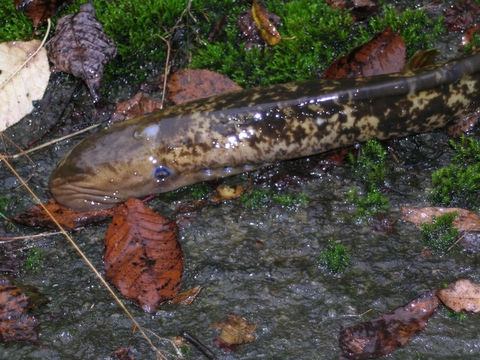ERROR : Server Busy(-1105)
ERROR : Server Busy(-1105)
Sea Lamprey (Petromyzon marinus) - Wiki
Sea lamprey
From Wikipedia, the free encyclopedia
[Photo] Sea Lamprey Petromyzon marinus Original from the Swedish Wiki. Photo: Joel Berglund Original text: Foto p?? havsnejon??ga fr??n Sk??lds??n som mynnar i G??ta ??lv.
The sea lamprey (Petromyzon marinus) is a parasitic lamprey found on the Atlantic coasts of Europe and North America, in the western Mediterranean Sea, and in the Great Lakes. It is brown or gray on its back and white or gray on the underside and can grow to be up to 90 cm (35.5 in) long. They prey on a wide variety of fish by attaching themselves with their mouths to the skin of a fish and rasping away tissue with its tongue and teeth. Secretions in the lamprey's mouth prevent the victim's blood from clotting. Victims typically die from blood loss or infection.
The life cycle of sea lampreys is anadromous, like that of salmon. The young are born in inland rivers, live in the ocean as adults, and return to the rivers to breed. Young emerge from the egg as larvae, blind and toothless, and live that way for 3 to 17 years, buried in mud and filter-feeding. Once they have grown to a certain length, they metamorphosize into their adult form, after which they migrate to the sea. After about 12 to 20 months, they return to the rivers and streams and spawn, after which they die.
Sea lampreys are considered a pest invasive species in the Great Lakes region. The species is native to the inland Finger Lakes and Lake Champlain in New York and Vermont. It is not clear whether it is native to Lake Ontario, where it was first noticed in the 1830s, or whether it was introduced through the Erie Canal, which opened in 1825.[2] It is thought that improvements to the Welland Canal in 1919 allowed its spread from Lake Ontario to Lake Erie, and while it was never abundant in either lake, it soon spread to Lake Michigan, Lake Huron, and Lake Superior, where it decimated indigenous fish population in the 1930s and 1940s. They have created a problem with their aggressive parasitism on key predator species and game fish, such as lake trout, whitefish, chub, and lake herring. Elimination of these predators allowed the alewife, another invasive species, to explode in population, having adverse effects on many native fish species. Control efforts, including electric current, chemical lampricides, and barriers, have met with varied success. Genetic researchers have begun mapping the sea lamprey's genome in the hope of finding out more about evolution, since it's been around much longer than the dinosaurs; scientists trying to eliminate the Great Lakes problem are co-ordinating with these genetic scientists, hoping to find out more about its immune system and fitting it into its place in the phylogenetic tree.
http://en.wikipedia.org/wiki/Sea_lamprey
| The text in this page is based on the copyrighted Wikipedia article shown in above URL. It is used under the GNU Free Documentation License. You may redistribute it, verbatim or modified, providing that you comply with the terms of the GFDL. |
|

